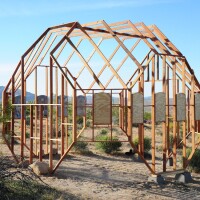
Artist's Wall in the Desert is All About Connections
Despite the relatively short hike from the parking lot up to Saudi Arabian artist Zarah Alghamdi's Desert X 2021 installation, "What Lies Behind the Walls," it still felt like a pilgrimage of sorts. The dark, monolithic wall of textured material loomed in the distance — a mecca to the migratory experience of memory from one desert to another.
Mercifully, midday temperatures in Desert Hot Springs were not yet in the full force of summer, so nothing more than a light sweat was kicked up, along with some inevitable dirt. It was Sunday, and there was a reasonable smattering of visitors taking the journey with me. Walking silently, with the wall in my line of vision, I overheard genial conversations of people visiting from New York, bringing with them their own cache of memory and experience with which to interpret this work.
At one point during my approach, a palpable sense of déjà vu swept over me — that mysterious sensation of remembering the present as having already happened before. I wondered if this was one of the mirage-like experiences of making pilgrimages in the desert, or if I was tapping into a pool of ancient human memory that this experience was evoking.
A couple of turkey vultures swooped above the wall, observing from their vantage point the curious sight of people lightly, tentatively touching the wall, a tangible expression of the textures of memory.








Looming closer, surrounded by desert, this wall struck me as vulnerable to the unforgiving elements of its environment. As I came to touch it, I understood why. Coated on the exterior with various materials such as cement, soil and dye, each carrying their own origin story and compounds of culture, the wall itself was spongy and soft. On such close inspection, the painstaking one-on top-of-another layering of matter and memory, place and time became evident — coalescing around a core with the texture of permeability.
What seemed like a monolith from afar revealed itself instead to be a process: layers of diverse material in dialog with each other and the surrounding drifts and shifts of the desert.
Nearby, a woman with her umbrella open to shield her from the sun talked animatedly on her cellphone about lunch plans.
What does lie behind the walls? The ones we put up around being with an experience beyond words?
Someone exclaimed how beautiful it was.
It seemed to me that this solitary wall, soft and solid, with its jostling layers in intimate conversation with the elemental desert, was indeed beautiful. But not in an objective way; not in the way of neatly fitting into an accepted notion of beauty. Like the memory it embodies, and the deserts it straddles, its beauty is one that will reveal itself over time and erosion.









